The Complete List of Foods That Start With the letter D
HurryTheFoodUp is reader-powered. If you click through using links on our site we may earn a small commission at no cost to you.
I started the journey with vegetables, then fruits – it is only fair that I end it with a comprehensive list of foods that start with the letter D, right?

From dandelion greens to the smelly durian, via dal, dark chocolate, and Devil’s food cake, I have such a complete list of D foods that you will never ever lose a round if your pub quiz was on the edible world of the letter D.
You can even appear on Mastermind with foods that start with D as your specialist subject, off the back of this!
But first: what counts as a food, for the purpose of this list?
Anything edible, of course! But no brand names. So you might find D for dark chocolate but no D for the brand of tortilla chips that sound like toridos. Capiche?
Apart from these, there are processed foods like deli meats, desserts like dulce de leche, even exotic foods like dosa and dolmades.
To round things off, there is the most comprehensive listing of fruits and veg that start with the letter D. If there’s something edible D food, I have it written down here!
Foods that start with D
Dal
Dal is both the name of the dish, as well as the ingredient it is made of. Used extensively in the cuisines of the Indian subcontinent, ‘dal’ stands for pulses – lentils, beans, peas, and the like.
The dried pulses are soaked, cooked, spiced gently, and eaten with rice or roti. The most popular one is the dal makhani.

Dahi vada
One of the most popular foods in Indian cuisine, dahi vadas are lentil fritters that are soaked in flavored curd. Mildly diluted curd is whipped, salted and a paste of grated coconut, soaked cashew nuts, and fresh coriander leaves are stirred in.
Freshly fried lentil fritters are then soaked in this delicious concoction till the air pocket in the vada are taken over by the goodness of the spiced yogurt mix.
Served sprinkled with crunchy sev or boondhi and grated carrots and fresh coriander, these are true crowd-pleasers.

Dauphinoise Potatoes
These are the posh French potatoes thought to have originated from the Dauphine region in France.
This is a rich potato casserole made of thinly sliced potatoes, cooked in cream, topped with cheese, and baked in the oven till they are nice and bubbly.
These potatoes make a great side dish with red meat dishes and fish dishes alike. If you are looking for a side to elevate your mains, this is it.
Deep dish pizza
Think of deep-dish pizza and you would automatically think of Chicago. The city is synonymous with this type of pizza and no visit to Chicago is ever complete without having a slice of a true Chicago deep-dish pizza.
As the name suggests, the crust is much thicker than the regular thin-crusted pizza, as the pizza is baked in a pan with a high edge, resulting in its characteristic ‘deep dish’.

Deviled eggs
A staple of summer picnics, deviled eggs are hard-boiled eggs that get a really fancy upgrade. The eggs are peeled, cut in half and the yolk scooped out.
The egg yolks are smashed together, mixed with generous dollops of mayo and mustard, seasoned, and spooned back into the egg white halves.
Herbs such as chives or dill are sprinkled on top before these magical eggs are scarfed down by eager picnickers!
Check out our own option of this great snack – the Avocado Deviled Eggs!

Denver Omelet
Walk into a traditional diner across the United States and chances are high that you will find the Denver omelet on the menu. Usually served with hashbrowns and toast for breakfast, the Denver Omelet is a proper meal in itself.
So what IS a Denver omelet? A classic omelet stuffed with diced vegetables such as onion, colorful peppers, cheddar cheese, ham etc, Denver Omelets are the perfect protein breakfasts to keep you going all morning.
Dhokla
From American breakfasts, all the way across the world to India, dhoklas are steamed besan (gram flour) cakes that are traditionally eaten for breakfast.
Served along with a coriander-mint green chutney, dhoklas are originally from Gujarat.
Fermented besan batter makes for a spongy cake when steamed and the resultant dhoklas are so light and airy, they go down real easy.
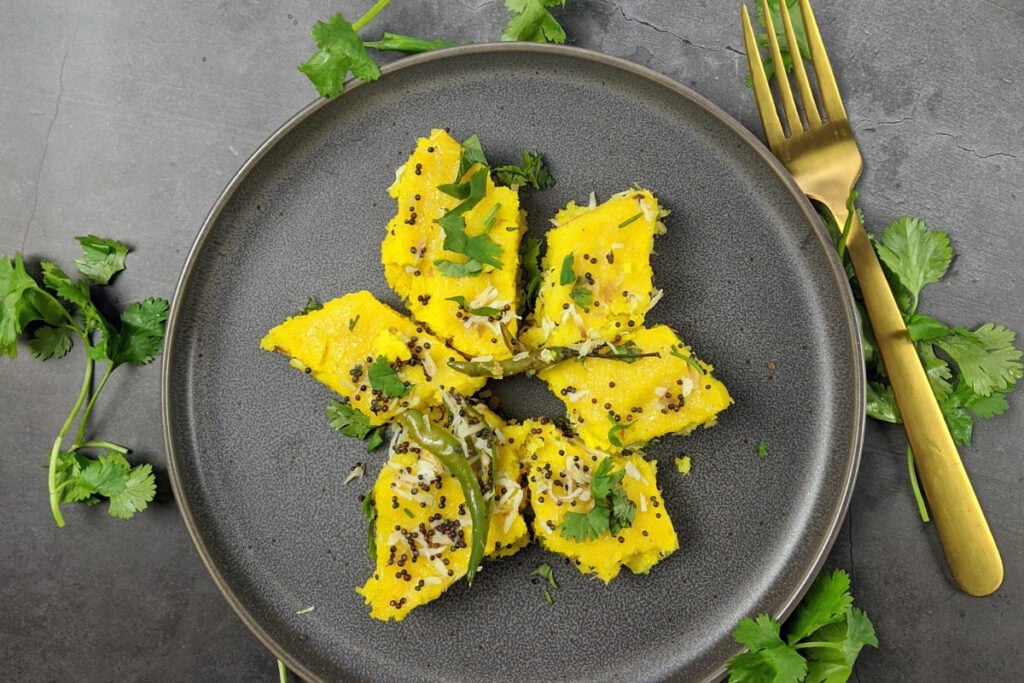
Dim sum
A staple of Chinese cuisine, dim sums are little pillows of dough that are stuffed with finely diced vegetables or meat and steamed in a bamboo steamer.
The edges of the dim sum are pleated with precision, giving them their characteristic appearance.
Dimsums are usually eaten for lunch or as a light snack, served with a dipping sauce made of soy sauce, chilli oil, crushed ginger, garlic, rice vinegar and sesame oil.

Dover Sole
Dover sole, as the name suggests, is a fish dish made with sole (a type of fish), a flatfish.
Called so because the best sole sold at the Billingsgate Fish Market in London were fished around the waters of Dover in Kent, England, is served with a rich bearnaise sauce or with a simple lemon butter sauce.
Either way, it is a sumptuous dining experience. Rumor has it that it is one of Wolfgang Puck’s (the Austrian-American chef and restauranter) favorite dishes.
Dosa
What crepes are to France, dosas are to India. Made with fermented batter of boiled rice and black gram, dosas are a breakfast staple in the south of India.
Thin batter is ladled on to hot griddles, spread thin and generously coated with oil.
When the dosas crisp up and turn golden, they are removed from the pan and served with sambar and different types of chutney.
Dolma / Dolmades
Dolma in Turkey (“stuffed”) and dolmades in Greece, these yummy parcels are stuffed grape leaves and a popular Meditteranean appetizer.
The stuffing changes from region to region but the usual ones are: cooked rice, pine nuts, raisins or currants, mixed herbs, even meat.
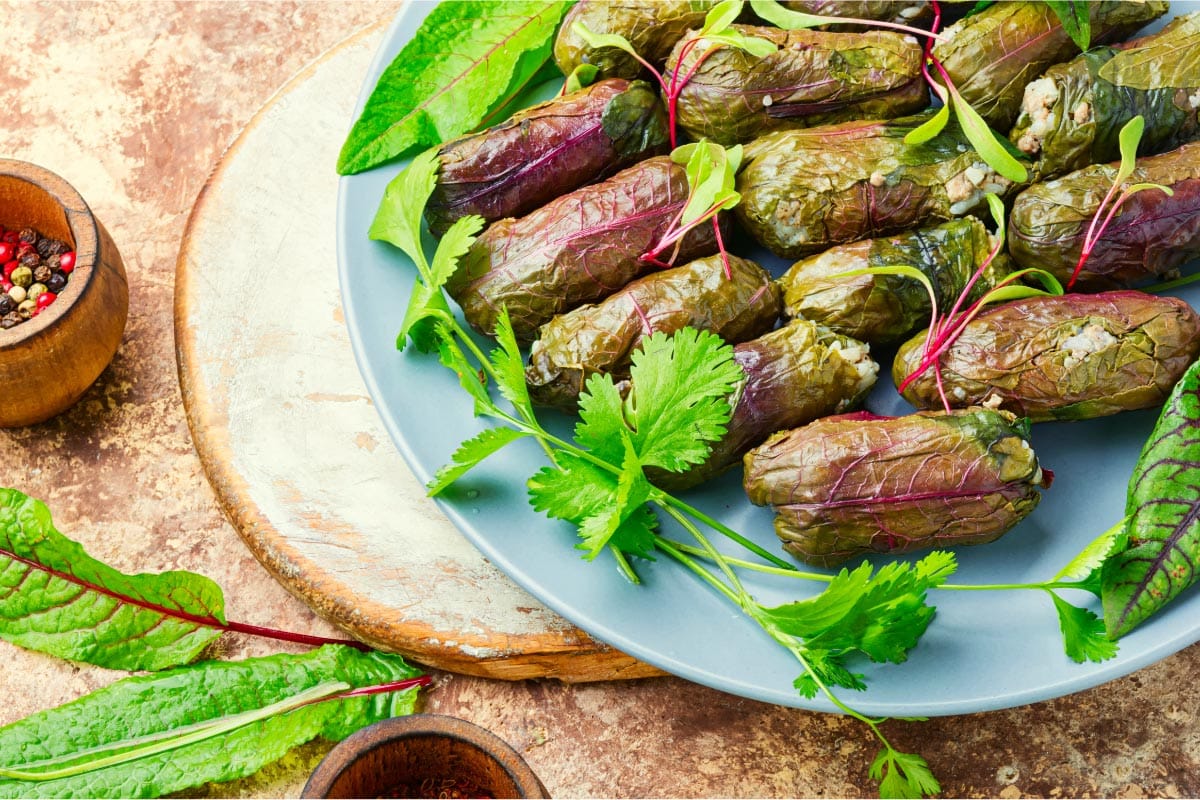
Dragon noodles
A stir fry that is a takeaway classic, Dragon noodles are fiery, unlike the regular lo mein noodles. Vegetables and cooked noodles are tossed in a hot sauce made of peanut butter, chilli sauce, lime juice and broth.
Dragon noodles come in both vegetarian and meat versions. If you are interested in trying your hand at making some, you can try our very own recipe!
Dum aloo
‘Dum’ is a way of cooking that enhances the flavor of the ingredients. Meaning ‘simmer’, it is a method of cooking made popular by the Mughal Empire.
Clay or metal pots are sealed and the ingredients – rice, vegetables or meat – are allowed to simmer in their own juices, leading to an intense explosion of flavors.
Dum aloo is a rich potato curry dish from the Kashmir Valley, wherein the potatoes (usually tiny, baby potatoes) are cooked in sealed pots, absorbing in the masala and juices from tomatoes and the spices.
Dum biryani
Biryani is not simply a dish, it is an emotion! Or so say the millions of Indians who consistently make this the most ordered dish across the restaurants in India!
A wondrous rice dish in which layers of vegetables, spices (and meats), herbs and seasonings are cooked slowly together, biryani has a rich and varied history across the Indian subcontinent.
A dum biryani is the method in which the biryani is sealed in a pot and cooked in a very low flame until the juices get infused in every grain of rice. The aroma that hits your nostrils when the seal is broken is unparalleled.
Durum wheat pasta
Durum wheat is a variety of wheat that has higher amounts of gluten and protein, when compared to regular wheat. It is the second-most cultivated variety of wheat and is primarily used to make semolina, bulghur and pasta.
Durum wheat pasta is rich in dietary fiber, vitamin B, iron, copper, zinc etc and so could be considered healthier than the regular variety.
Processed foods with D
Deli meat
Cold cuts, lunch meats, sandwich meats are processed slices of meat that are served hot or cold. Usually stuffed in sandwiches with cheese and condiments, these are popular lunchbox staples.
Dijon mustard
Named after the town of Dijon in the Burgundy region in France, Dijon mustard is the most famous condiment of France.
The French love for mustard stretches back to the Middle Ages, when France was the mustard making capital of the world!
In its original format, Dijon mustard was first served to the monarch, King Philip VI in 1336. Today, the condiment is manufactured not in Dijon, but in a nearby town, while the mustard is grown in Canada.

Doner kebab
Doner kebab is a kind of kebab in which meat is tacked onto a vertical rotisserie and cooked slowly all day. Bursa, in Turkey is considered the birthplace of the doner kebab.
Cooked meat is sliced off the rotisserie and served on a flatbread such as lavash, along with sliced salad vegetables and various accompanying sauces.
Originally from Turkey, doner kebabs are famous across the world, especially in the UK.
Dukkah
Dukkah or duqqa, is a Middle Eastern condiment made of herbs, nuts and spices.
The word ‘dukkah’ comes from the Arabic word for ‘pounding’.
Dry roasted spices such as sesame, cumin seeds, coriander seeds, pepper etc are hand pounded and used to season fresh vegetables or mixed in oil and used as a dip for bread.
Try out our Authentic Egyptian Dukkah recipe! It’s so versatile!
Sweet foods with D
Danish pastry
A type of puff pastry originally developed by Austrian bakers before brought to Denmark, Danish pastry (or simply, just a Danish) is a favorite dish of a Continental breakfast spread.
It belongs to the viennoiserie family of pastries just like a croissant.Danish pastry is made of yeast-leavened dough which is rolled thinly, folded and repeated till it gets to 27 layers of puff pastry! Do you know something funny?
The dish that is called as Danish pastry the world over is known as Viennese bread (wienerbrod) in Scandinavia!

Dark chocolate
The food that was the food of the Mayan Gods more than 2000 years back, the chocolate has been a highly prized and much loved food since. Dark chocolate is made of cocoa solids (between 50 and 90%), cocoa butter and sugar.
Dark chocolate are rich in flavanols,which are plant chemicals that help in lowering blood pressure, help protect your heart and even help with insulin sensitivity.
Devil’s Food Cake
Imagine a luscious dark chocolate cake – but only richer, deeper, darker and more fluffy than a regular chocolate cake. There’s your Devil’s Food Cake!
I have always wondered why this special party cake is called as devil’s food’. Turns out, our ancestors decided that any dish that was this rich and ‘sinful’ as this cake ought to be ‘devil’s food’ – hence, Devil’s Food Cake.
The cake is typically contains dutch processed cocoa powder, butter, sugar, baking soda, sour cream and coffee.
Donut
Donut (or doughnut) is a circular, deep-fried sweet treat made of flour that is either has a characteristic hole in the middle or is filled. Fillings include jams, cream and chocolate.
The world over, doughnuts are made and sold in bakeries, fun fairs, market stalls and are a firm party favorite.
Though deep fried dough has always been existence in some form of the other across the ages, the credit for the highly recognizable American version – ie, with the hole in the middle – goes to a New England sea captain from mid-19th century called Captain Gregory.

Dulce de Leche
Silky, thick, light brown coloured and tasting pleasantly of caramel, dulce de leche is the poster child of decadence.
A confection from Latin America, dulce de leche is made by slowly cooking milk and sugar over a low flame for a long time, till the milk caramelizes.
Creamier than regular caramel, dulce de leche can be used in making cookies, cakes, cupcakes, ice cream and or even simply stirred into coffee.
Drinks with D
Darjeeling Tea
A special variety of black tea that is grown exclusively in the estates of Darjeeling and Kalimpong in the state of West Bengal in India, Darjeeling tea was first planted in 1841 to counter the teas grown and exported from China.
Over time, the Darjeeling tea has garnered an exclusive reputation to be known as the ‘champagne of teas’.
Dark roast coffee
Stronger and darker than regular coffees, dark roast coffee results when the coffee beans are roasted at 204 degrees celsius for 15 minutes or so, until their inner temperature reaches 240 degrees (no more than 249 degrees).
Dark roast coffee packs a wallop in terms of depth of flavor and aroma.
Dark roast coffee is considered one of the best source of antioxidants that help our body in fighting free radicals.
Dark rum
Rum is an alcoholic beverage made by fermenting and distilling sugarcane juice or molasses and aged in oak barrel. Rum is generally sold in two varieties – light and dark.
Rum has been around for a very long time – Marco Polo has recorded imbibing a ‘wine’ made of sugarcane in his travels.
Dark rums are produced mainly in the islands of the Jamaica, Haiti, Martinique and the Bahamas.

Draught beer
Draught or draft beer is beer that is served directly from a beer keg or a cask. The earliest reference to draught beer records medieval monks storing beer in barrels.
The word ‘draught’ comes from the Old English word “dragan”, which means “to pull or carry”. From early 20th century onwards, beer has been stored in pressurized containers.
Dirty martini
Martini is a cocktail that is made of gin or vodka, vermouth and garnished with olives, lemon rind or pearl onions.
A ‘dirty’ martini is one that has a splash of olive juice or olive brine and garnished with olives.
Fruits that start with D
Dabai fruit
Glossy and black in color, with a yellow flesh and an edible seed, Dabai can be eaten raw or blanched or cooked into a sauce. It is also eaten with sugar, salt, or even soy sauce.
Dabai fruit (scientific name Canarium odontophyllum) is a seasonal fruit native to the islands of Borneo.
The fruits are available between the months of October and January.
The fruit is so special to the locals that they even have an annual festival called ‘Pesta Dabai’ to celebrate it!

Damson Plums
Damsons are a small fruit, with a hard stone in the middle, and are usually harvested between late August and September/October.
Damson plums (scientific name Prunus insititia) are fruits native to Great Britain. In fact, its name is derived from Middle English – proof positive that this plum has been around for a while!
Unlike the other varieties of plums, Damson Plums have a rich sweet flavor and as well as being highly astringent.
While not exactly filling the fruit aisles at the supermarket, you might be more familiar with the damson fruit in jams, fruit preserves, and even gin.

DangleBerry
Dangleberry (scientific name Gaylussacia frondosa), also known blue huckleberry, is a small shrub that grows in eastern USA. The plant produces small edible fruit that are bluish-black like blueberries or sometimes even white.
The dangleberry plants are essential to the local ecosystem as they are bird-, bee- and butterfly-friendly, and quite attractive to wildlife.
Date
Date, the fruit of the date palm trees, is cultivated predominantly in north Africa, the Middle East, and South Asia. Date palms are emblematic of the Middle East and are used extensively in the local cuisine.
The raw fruits of the date have a mild, sweet taste but we are more familiar with the zhuzhed-up versions that are glazed in sugar syrup and stuffed with cashew nuts and almonds.
This sweet fruit is also a chief ingredient in desserts in Middle Eastern and Indian cuisines.
Did you know that dates (scientific name Phoenix dactylifera) have been around since the days of the Indus Valley civilization? This hardy plant has been in existence for over 50 million years! Imagine that!
Date Plum
The Ancient Greeks called these “God’s fruit”! How about that?! Date plums are quite sweet and tart to taste and are usually eaten dried.
Not to be confused with the regular dates, date plums (scientific name Diospyros lotus) also known as the Caucasian persimmon, are delicious fruits native to southeastern Europe and southwest Asia.
The fruit is called date plum as apparently the taste of this fruit is rather like a mix of dates and plums! Yum!
Darwin’s Barberry
Darwin’s Barberry is a flowering evergreen thorny shrub that is native to South American countries Chile and Argentina. The plant produces small purplish-black fruits that are quite acidic in flavor.
Did you know Darwin’s Barberry (scientific name Berberis darwinii) is named so, in honor of Charles Darwin because he discovered the plant in South America in 1835?
The prehistoric native people of Patagonia consumed the Darwin’s Barberries over a millenia ago.
In the UK, the plants make for highly popular hedging shrubs, while in the New Zealand, the plant is considered a pest, as it is highly invasive and destructive to native ecosystems!
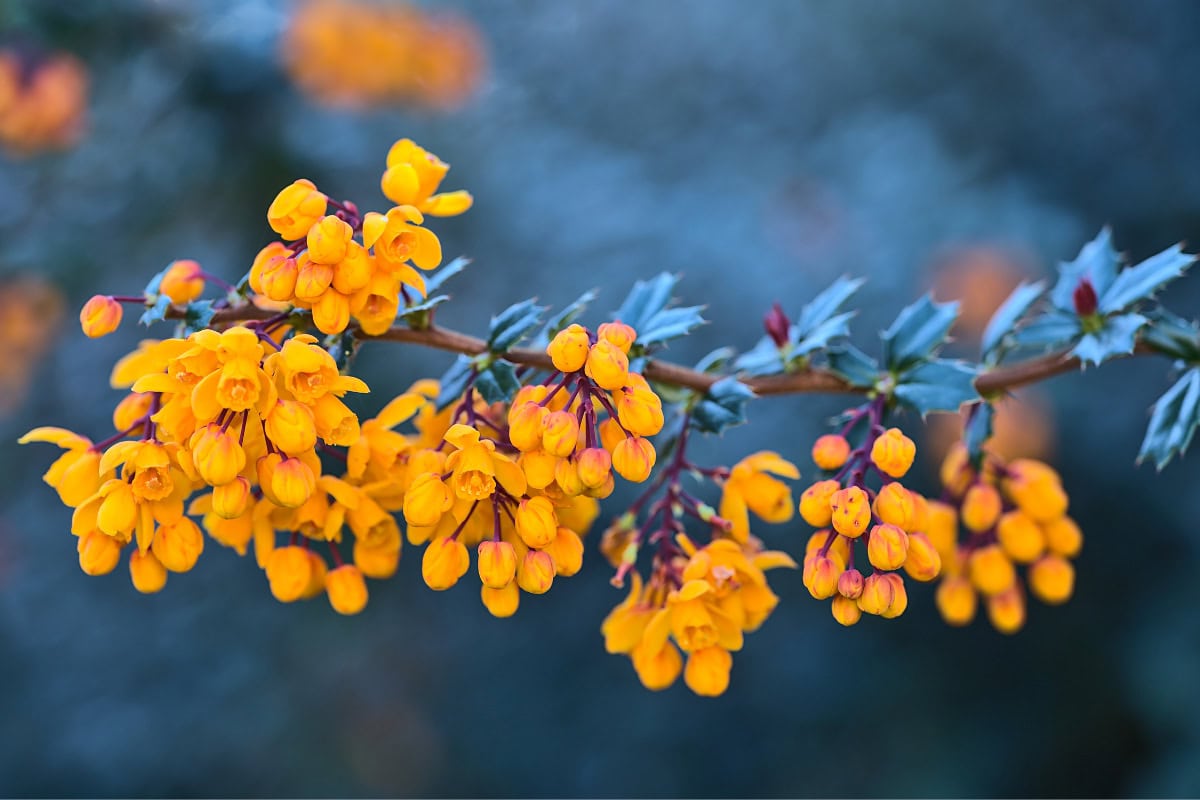
Davidson’s Plum
If you have watched Masterchef Australia, (or are from Oz!) you would be familiar with this fruit. Davidson’s Plum (genus Davidsonia) is found exclusively in Australia and refers to not one, but three rainforest trees.
Davidson’s plums look quite similar to the European plums but unlike them do not have a stone inside. The flesh of the fruit has a burgundy hue and a sour taste.
The fruit is used in jams, sauces, wine, and ice cream.
Dead Man’s Fingers
Not a very appealing name now, is it? Imagine walking into Sainsbury’s, asking for a punnet of Dead Man’s Fingers?!
Then again, look at the picture of these poor fruits in nature and they do look rather like cadaverous, like long and purplish sausages.
Also known as blue bean plant and blue sausagefruit, the Decaisnea is native to Asian countries such as China, Nepal and Myanmar. The fruit is quite tasty, rather surprisingly, like a cucumber.
Dekopon
Dekopon or Shiranui is a seedless variety of satsuma orange, a hybrid variety developed in Japan.
These fruits are very popular in their country of origin, Japan, as well as in Brazil, South Korea and Azerbaijan.
In fact, the plants have been adapted successfully to the Brazilian climate and are cultivated in the highlands of Sao Paolo state.
Dekopans are small fruits that are quite acidic in nature. This is why they are left to their own devices for anything from 20 to 40 days post harvest, in which time the fruits lose their acidity and increase in sweetness.

Desert King Fig
The Desert Fig (scientific name Ficus carica) is a type of fig found predominantly in the Pacific Northwest. It is a striking fruit with yellowish green skin and a bright red flesh.
Thought to come from a fig tree found in 1930 near Madera, in California, the Desert Fig is a highly prized fruit.
The Desert King figs are rich and delicious – the fruits are very sweet, tasting like a cross between a strawberry and a mulberry.
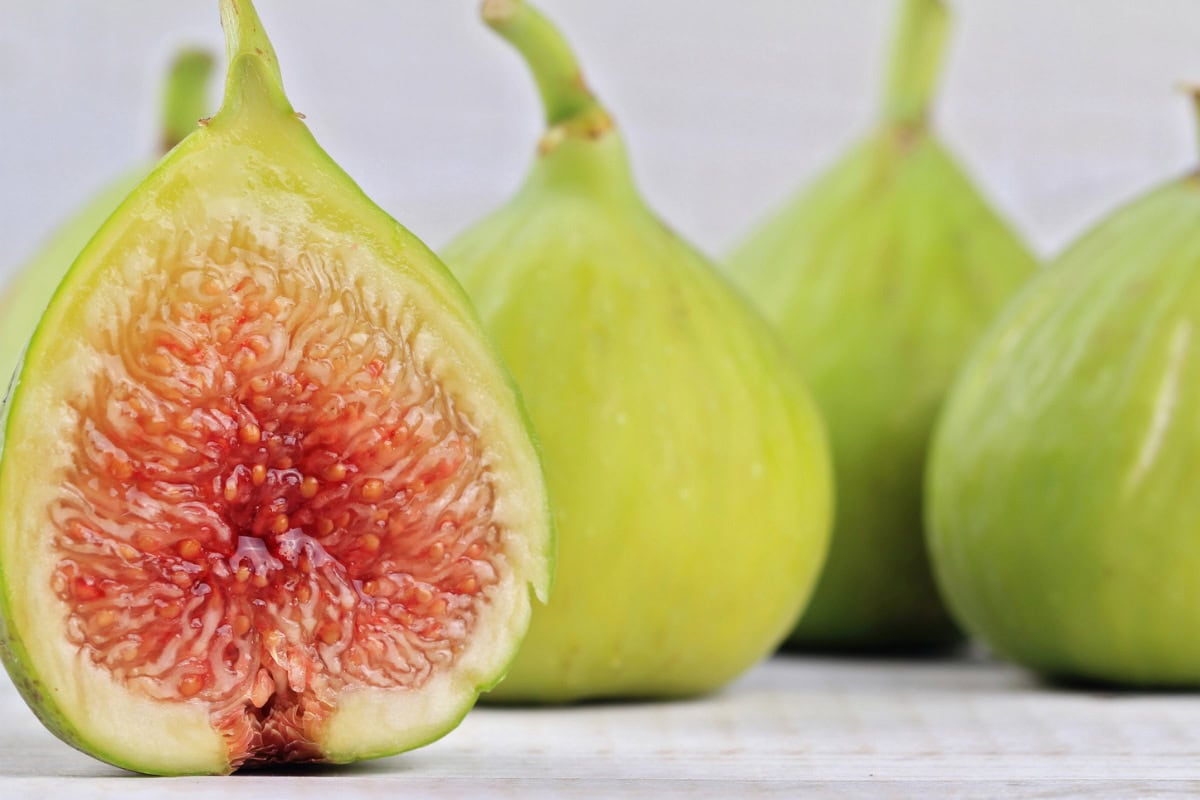
Desert Lime
Desert Lime (or citrus glauca) is, as name suggests, a citrus fruit native to Australia, especially South Australia, Queensland and New South Wales. The fruit has a very strong flavor, like a lime.
It is a hardy plant that is heat, cold, drought and salinity resistant. Traditionally found in the bushlands, desert limes are used to make marmalades, drinks and candied peels.
Desert Quandong
Santalum acuminatum, the desert quandong, is a plant that is native to Australia. They grow extensively in the arid regions of the central desert and the southern parts of the country.
Also known as native peach, the quandong fruit is one of the most famous foods of the bush.
The quandong fruit is used in pies and in fruit juices. It has a flavor profile is similar to that of a rhubarb or a peach and so, is used in both sweet and savory foods.
In foreign markets, it has gained popularity as an exotic fruit.
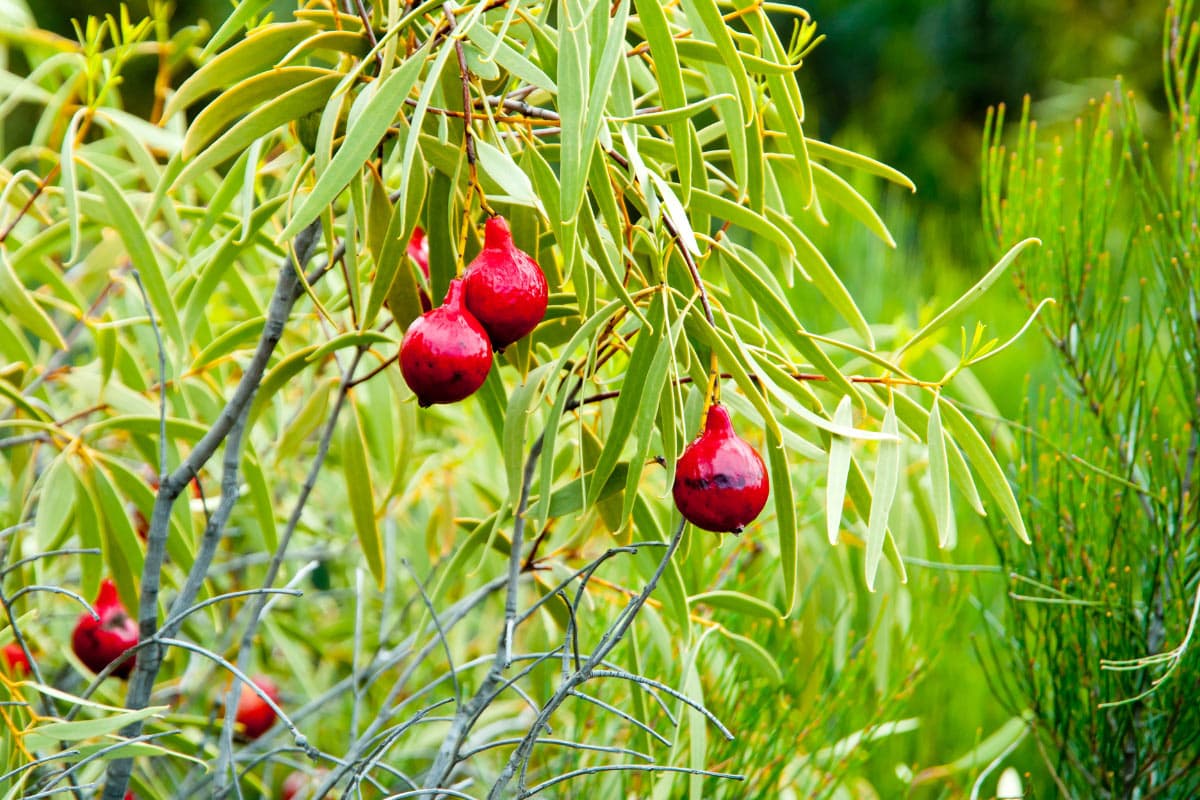
Dewberry
Dewberries (genus Rubus) are small berries related to blackberries. Soft, sweet and less seedy compared to blackberries, the tender dewberries are rather difficult to pick. They get squished so easily!
Though considered a weed, dewberries are considered beneficial. These plants are found commonly across the Northern Hemisphere.
Dewberries are used to make jams, pies and cobblers. The leaf of the Dewberry plant is used to make herbal tea.

Dinosaur Egg or Pluots
Have you heard of pluots? Pluots or dinosaur eggs are a hybrid of plums and apricots. Cross-pollinating the two fruits results in pluots with a variety of unique flavors, taking on varying percentages of taste profiles from both fruits.
Why are pluots called Dinosaur eggs though? Funnily enough, the skin of the fruit is colourful and spotted, which apparently brings to mind dinosaur eggs! Fun!
Dino eggs are used in various dessert preparations such as pies, tarts and crumbles. (These should be served in Jurassic Park!)

Dinosaur Melon
Originally developedi in Japan, it is now found in other parts of the world such as China, southern California, Mexico and South America.
Dinosaur melons (of the species Cucumis melo) are small to medium-sized fruits with a mildly sweet flavor.
Dinosaur melon, also known as dino egg melon or gaya melon is a small variety of honeydew melon. This popular fruit is rather unique to look at, with ivory coloured skin with green streaks and white inner flesh.
Discovery Apple
The Discovery apple is a small to medium fruit, with a sweet, lightly acidic flavor, kind of like a strawberry. Belonging to the species Malus domestica, Discovery Apple is a dessert apple.
Originally cultivated by British farmer George Dummer in in 1949, the Discovery Apple was first introduced to the market in 1962, by a Sussex nurseryman called Jack Matthews.
As a nod to the original developer, the Discovery was first called ‘Dummer’s Pippin’.
Double Coconut
The Double coconut palm trees are used as ornamental trees and its fruit is not consumable in the traditional sense.
But in traditional Chinese medicine (TCM), the double coconut is considered a valuable medicine, as it is used to treat abdominal pain, inflammation, nausea etc.
Double coconut, sea coconut or coco de mer (scientific name Lodoicea) belongs to the palm family. It grows extensively in the Indian Ocean islands, especially Seychelles, Maldives and Madagascar.
It is also known as the Maldive coconut.
Dracontomelon
Dracontonmelon (scientific name Dracontonmelon duperreanum), refers to a family of flowering plants, found in South East Asia.
The fruit of the plant is eaten by the people of China, Cambodia and Vietnam, where the plant is commonly found.
Dracontomelon fruit is used as a souring agent in Vietnamese cuisine and as a candied treat, popular among the youth.

Dragon Fruit
Also called pitaya or a strawberry pear, dragon fruit (from the family Selenicereus) refers to the fruit of a type of cactus plant found in the Americas.
The dragon fruit is native to southern Mexico, El Salvador, Guatemala and Costa Rica.
The name of the fruit comes from the rough texture of the skin of the fruit. There are many sub-varieties that make up the dragon fruit, some sour and some sweet.
The inner flesh of the fruit is comparable to that of the kiwi fruit, because of the seeds present in it.
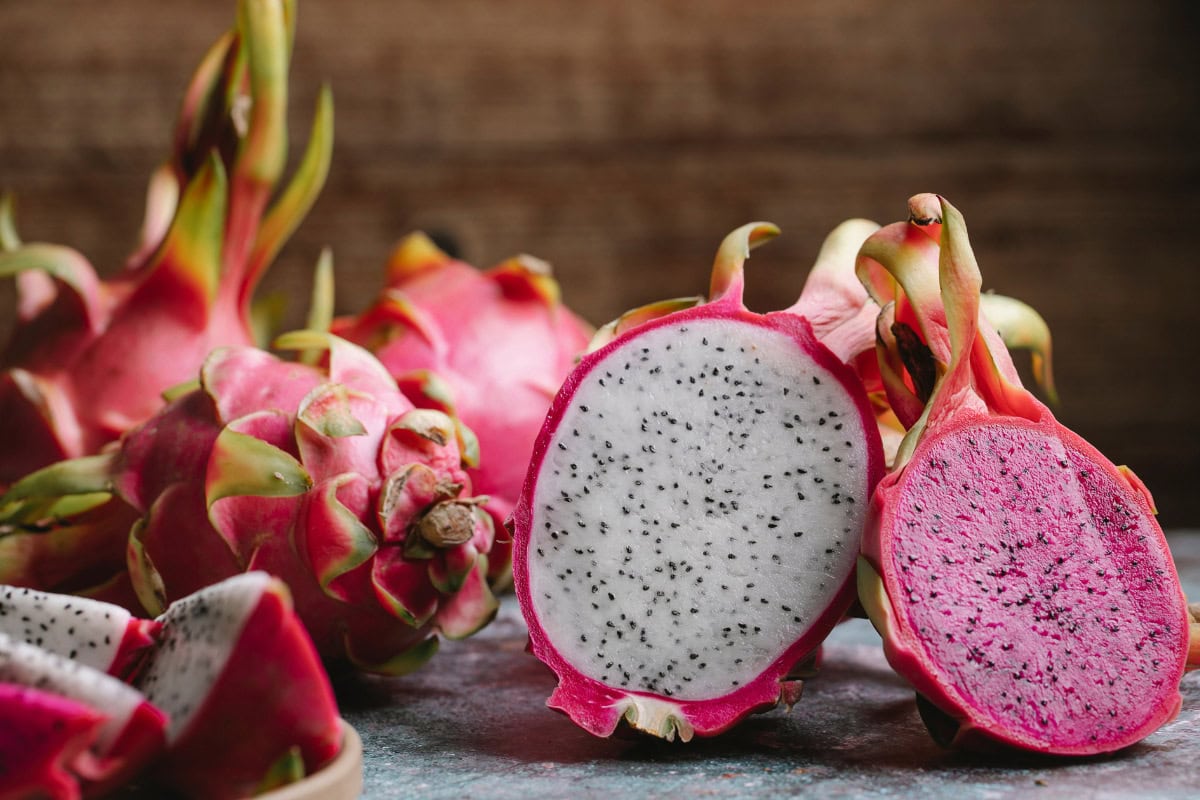
Durian
The poster child for exotic fruit, one whose fame had spread far and wide, would be the durian fruit.
Called the ‘smelliest fruit in the world’, durian has over 400 varieties! It has a strong smell that can linger for days! No wonder many international hotels in the region have banned this fruit from their premises!
The marmite of the fruit world, the tropical fruit durian invokes no ambivalence. Folks either love it, or hate it. Or run from it!
As a matter of fact, durian (scientific name Durio zibethinus) is called the king of fruits and is hugely popular in Southeast Asia, where it is used in both sweet and savory dishes.

Duku fruit
Duku (scientific name Lansium parasiticum) is also known as langsat and lanzones, is the fruit of a tree from the mahogany family. The plant is native to Southeast Asia.
The fruit has a texture akin to grapes when eaten raw and is also used to make fruit syrup. The fruits have a flavor like grapefruit, both sweet and tart.
Duku is an excellent source of essential vitamins and minerals, like Vitamin A, Vitamin B, Vitamin C, iron, phosphorous etc.

Dusky Pear
Dusky pear (scientific name Pyrus phaeocarpa) is a variety of pear closely related to the Himalayan pear.
Dusky pear is native to China and the fruit trees are covered in beautiful flowers. Which makes them highly sought after as ornamental trees.
Vegetables that start with D
Dabberlocks
Also known as bladderlocks and wing kelp, dabberlocks are common algae found in the northern hemisphere, especially around the British Isles. Their scientific name Alaria Esculenta literally means ‘edible wings’.
Dabberlocks are highly nutritious and are eaten in Scotland, Ireland, Greenland, and Iceland, in raw and cooked forms.
Daikon Radish
Daikon radish, or winter radish, is a root vegetable that is mild in flavor. It has a sharp, spicy flavor when eaten raw, and so adds a lively note to salads.
Daikon radishes (scientific name: Raphanus sativus var. Longipinnatus) are quite popular in Indian and Japanese cuisine. Easily found in your corner grocery store, Daikon radishes can also be pickled or sauteed in stir-fries.

Dandelion Greens
Aren’t dandelion plants weeds? Why are we chomping down weeds? Fear not, my friend, dandelion greens (scientifc name Taraxacum) are perfectly safe for us humans to eat.
What’s more, they are a treasure trove of vitamins and minerals. Dandelion greens are excellent sources of vitamins A, E, K, C, phosphorus, calcium, sodium, and potassium and can be cooked just like other greens like spinach, kale etc.
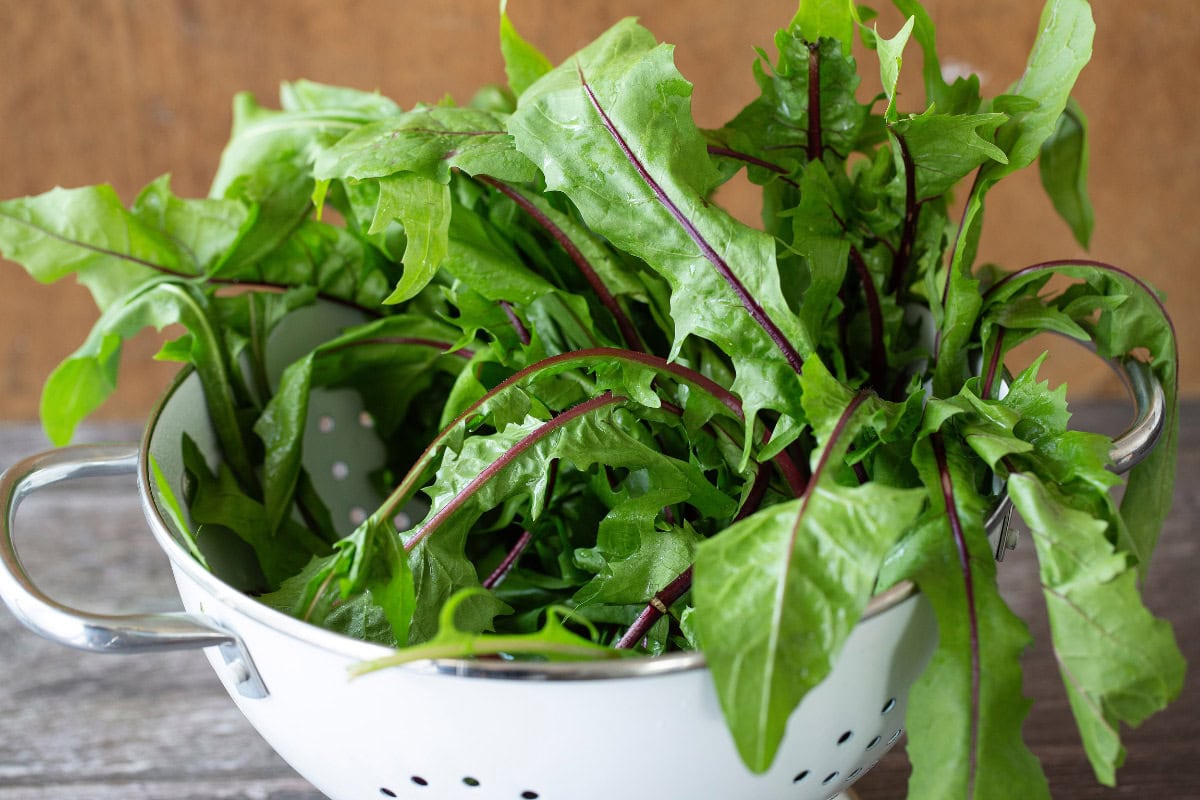
Dasheen
Dasheen (scientific name Colocasia esculenta), popularly known as taro, is a root vegetable and is a staple in many African, South Asian, and Pacific cuisines.
In fact, it has the honor of being one of the earliest cultivated plants!
Don’t make the mistake of eating this veg raw – they need to be peeled, boiled, and then cooked to be fit for consumption. The leaves of the Dasheen plant are also edible and make delicious treats when cooked with spices.

Datil pepper
‘Datil’ means ‘date’ (as in, the fruit of the date palm tree) in Spanish, as it is said that this pepper resembles the shape of a date palm. It rates around the same as a habanero, on the Scoville heat rating scale.
So not too grim, I would say.
Fruity, sweet, hot – the many words used to describe Datil pepper (scientific name Capsicum chinense ‘Datil’). This yellowish-red-gold pepper is grown mainly in Florida, in the United States, especially n the St Augustine area.
Fun fact: the first Saturday in October is known as “Datil Pepper day” and the pepper is the “official plant” of St John’s County. A pretty popular plant, huh?
Daylily
What could be more fun than having your very own edible garden? If you are planning one, daylilies should be a big part of it!
Not only is this flowering plant gorgeous to look at, but the most common variety, Hemerocallis fulva, is also really flavorsome. You can eat the tubers, the flowers, and the stalks of the daylily plant.

Death Spiral Pepper
Not something you would like to find in your Friday curry, eh what? It is supposed to contain citrusy and floral notes, but the pepper loses me at “Death Spiral”.
It is 560 x hotter than jalapeno, for crying out loud! The only saving grace is its small size!
A name that makes you want to start scarfing it down – not!
A pepper that is gnarly, ugly-looking and frankly, quite scary – measuring an unholy 1,400,000 Scoville heat units, this pepper ranks right up there with the grim-sounding Carolina Reaper.
It changes colour as it ripens, turning red from light green, via peach and orange. Oh and they develop a bit of a ‘tail’ too! Such fun!
Delicata Squash
A versatile that can be baked, stuffed, steamed, oven-roasted, or sauteed in a pan, the delicata squash is just what you need in a veg! The delicata squash is a winter squash variety with pinstriped skin.
Though this variety is not full of beta-carotene like the usual pumpkins and squashes, the Delicata squash does contain Vitamin B and Vitamin C, as well as important minerals like magnesium and manganese.
As for the taste, the Delicata squash (scientific name: Cucurbita pepo ‘Delicata’) is a tasty vegetable that is almost a cross between sweet potato and butternut squash.

De 18 Jours Radish
The De 18 Jours Radish (scientific name: Raphanus Sativus), also known as French breakfast radish, is a gorgeous looking plant and one of the quickest growing of any radish.
These gorgeous looking baby radishes are an old French heirloom variety. Their name translates to ‘of eighteen days’ as these radishes taste fresh with they are 18 days old.
Makes a spicy and crunchy addition to any salad, these radishes!
Diamond Bell Pepper
An unusual variety of bell pepper, the diamond bell pepper (scientific name: Capsicum annuum) is a translucent variety of pepper, with a sweet flavor. With their startling ivory-colored flesh, these peppers are quite striking to look at.
These are quite rare and are grown mainly in America. Rich in flavor and crunchy in texture, the diamond bell peppers are fab to eat raw and make wonderful additions to salads.
Diamond Eggplant
Eggplants (scientific name: Solanum melongena) belong to the nightshade family and diamond eggplants are the traditional variety.
Known as aubergine in the UK, these tasty vegetables are long and purple in appearance. Sweet-tasting and not bitter, unlike regular eggplants, the diamond eggplants taste heavenly when grilled.
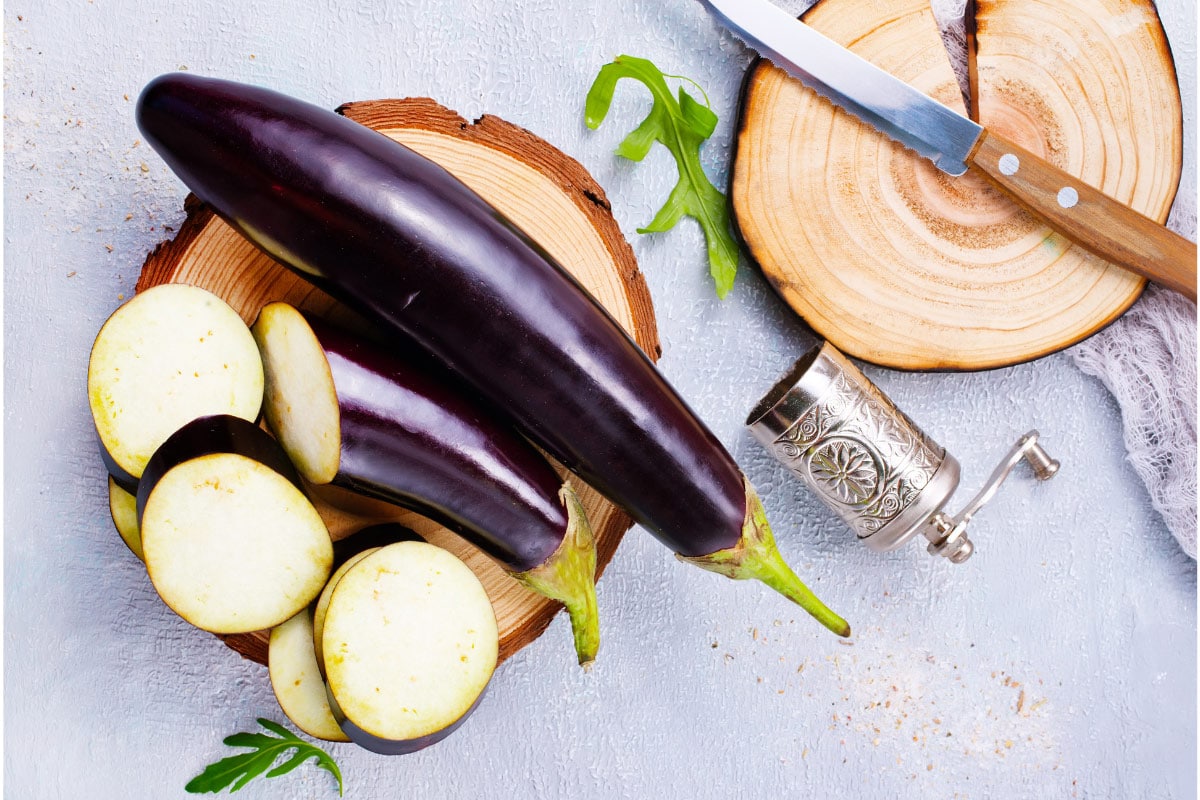
Dickinson Pumpkin
When is a pumpkin not a pumpkin? When it is a Dickinson pumpkin!
Fun fact: Dickinson Pumpkins aren’t actually pumpkins at all, but squashes and belong to the same family as the butternut squash!
When you open a can of pumpkin, the variety that is usually canned is the Dickinson Pumpkin (Cucurbita moschata).
Looking more like a watermelon than a traditional pumpkin does, these pumpkins are the variety to go for if you are keen to grow or buy pumpkins to eat, in bread, curries, salads or in pies.
Dill
Herb, curry ingredient, pickle – you name it, dill has a starring role in each. A type of herb related to the celery plant, dill leaves, and seeds are used to garnish soups and salads. Of course, dill pickles are hugely popular in delis everywhere.
Aromatic and flavorful, dill (scientific name: Anethum graveolens L.) leaves are used by cooks everywhere to add some oomph to their dishes.

Did you know though, that dill is also rich in antioxidants and minerals, and is also used to treat digestive ailments? Gripe water given to babies with gassy tummies contains dill.
Dolichos Beans
Also known as lablab beans, hyacinth beans, or Indian beans, these beans (scientific name: Lablab purpureus) come in both green and purple varieties.
Sliced and cooked in a pan, these dolichos beans are a popular ingredient across the tropical areas of the world – India, as well as East and SouthEast Asia, and East Africa.
A climbing plant, the seeds, pods, leaves, and roots of the Dolichos bean are edible.
Dinosaur Kale
Budding palentologists, I have found the perfect veg for you! The bumpy leaves of this kale variety are supposed to resemble dinosaur skin, hence the name. Cool or what?
Boring adults might know this type of kale better as cavalo nero (scientific name: Brassica oleracea var. palmifolia), but “dinosaur kale” sounds way more fun, right? And, dare I say it, more fun and appealing to kids (and most everybody?)!
The variety is grown extensively in Tuscany and features in traditional Tuscan foods, such as ribollita, minestrone etc.
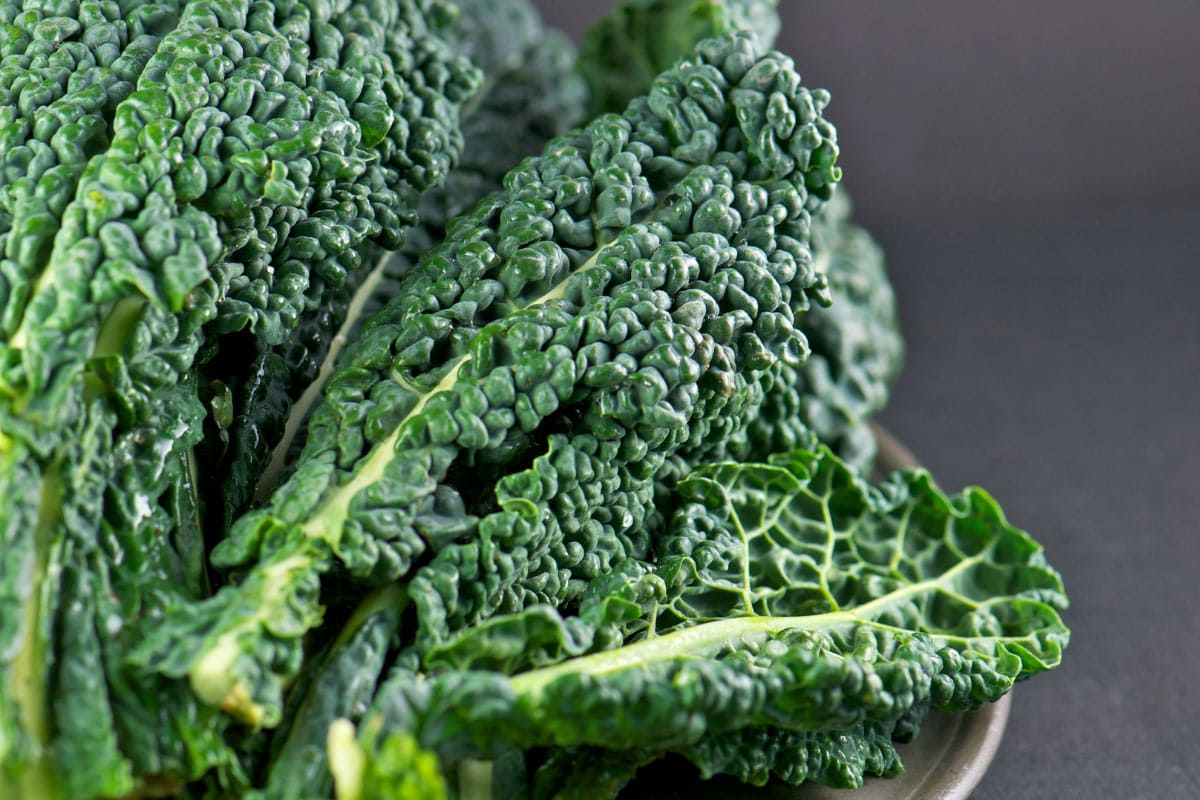
Double Beans
High in dietary fiber as well as essential minerals like potassium, calcium, phosphorous, sodium, and iron, double beans are a good source of protein for vegetarians and vegans.
Double beans (scientific name: Phaseolus lunatus), butter beans or lima beans are legumes that are eaten extensively in the Americas, Spain, and South Asia.
Dragon Carrots
Purply-red on the outside and yellowish-orange on the inside, the Dragon Carrots (scientific name: Daucus carota) are as far as you can get from the bog standard orange ones you see on the regular, as you can get.
The taste profile of these carrots is quite different to the sweetness of the orange carrots too. These ones are actually a bit spicy – we can totally guess where the ‘dragon’ comes from!
Originally from China, the Dragon Carrots are excellent served raw, in salads.
Dragon Tongue Bush Bean
More flamboyant-looking than the regular French bean with its purple streaks, the dragon tongue bush beans (scientific name: Phaseolus vulgaris) are an old Dutch heirloom variety.
They taste delicious eaten fresh, with their tender outer layer or as dried beans. This type of bean is tasty eaten both raw and cooked. This bush bean hugely popular with chefs and gourmands for its popping flavor.
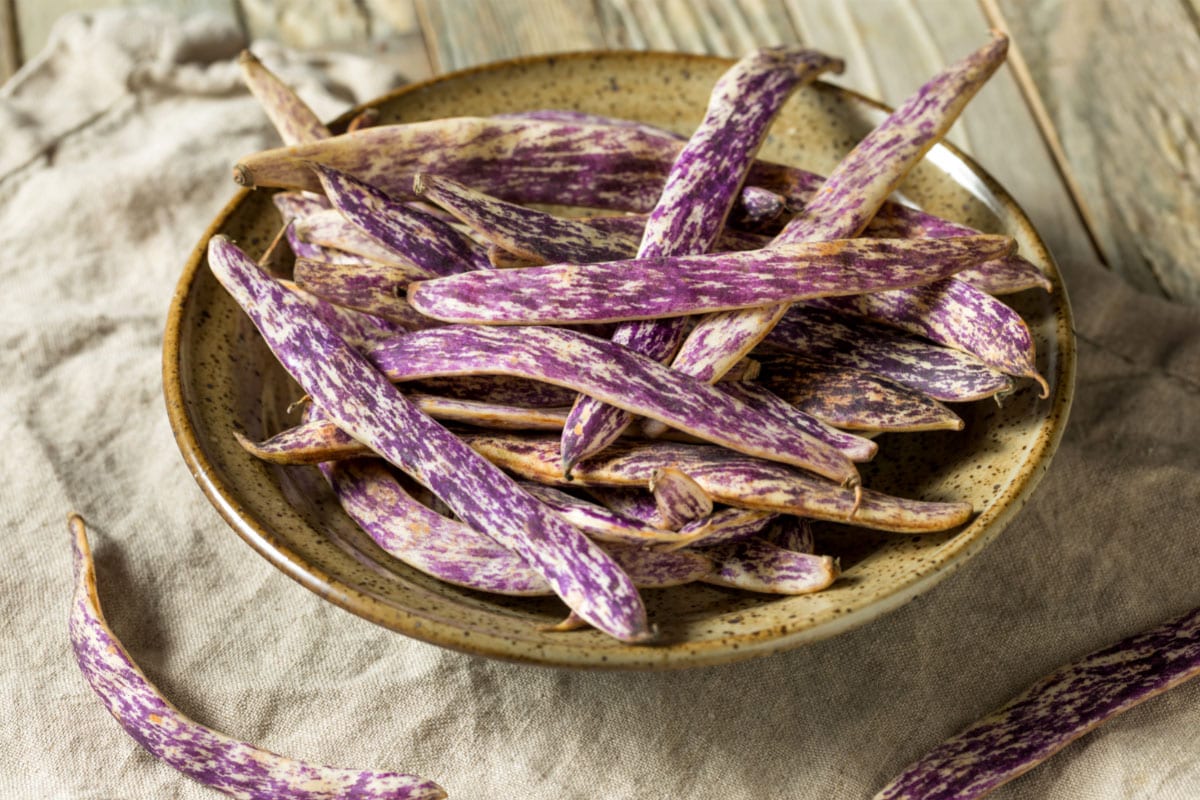
Dubna Garlic
First found in Dubna, Russia, from where it gets its name, the Dubna garlic has large to jumbo sized bulbs.
A variety of heirloom garlic, the Dubna Garlic (Allium sativum) is a gorgeous looking bit of veg. It sports a jaunty marbled purple streak, which is carried on the outside too, on the wrappers.
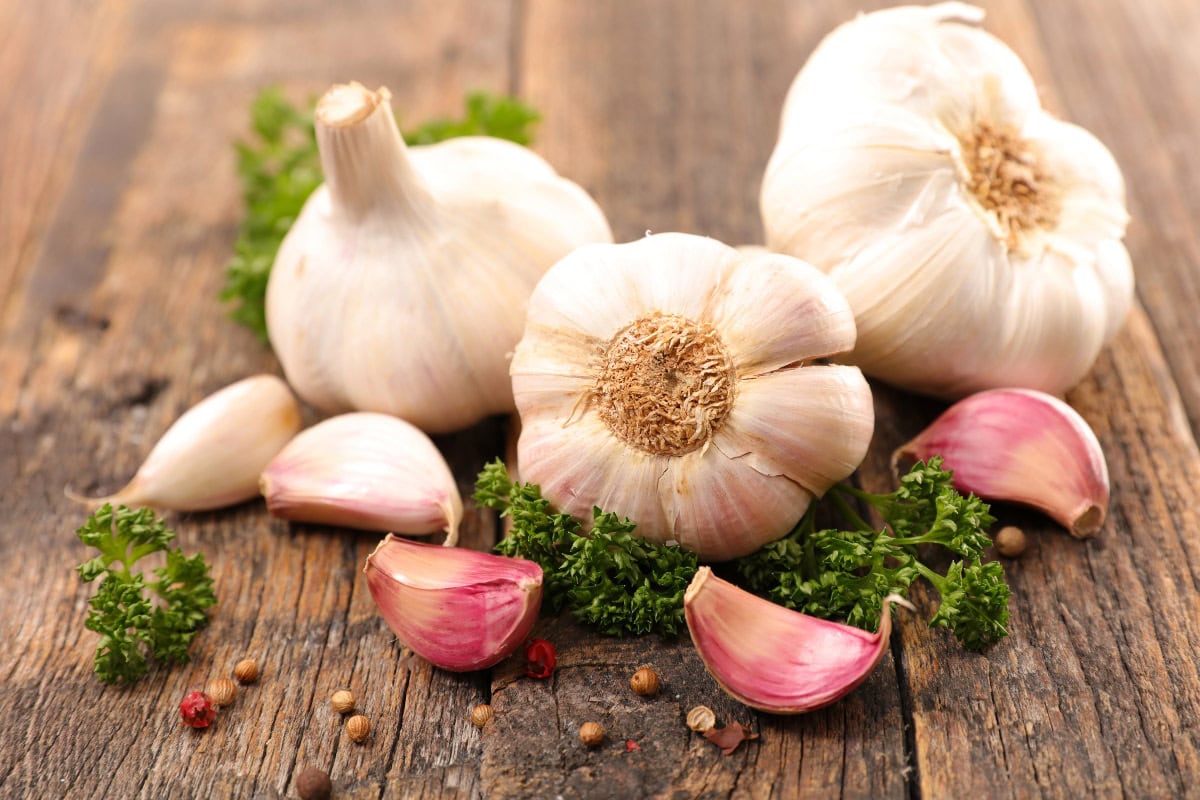
Dulse
Dulse, also known as dillisk seaweed or palmaria palmata, is a red algae that grows on the northern coast of the Pacific and Atlantic oceans and being quite nutritious, is very important to the seafaring people.
A popular snack, Dulse is an important dietary fiber of Icelandic cuisine. In Northern Ireland, Iceland, and North America, this seaweed is used both as a medicine and a food.
It possesses a mildly spicy and salty flavor. Once dehydrated, it is also used as a garnish, and a snack.
Drumstick
Popularly known as moringa, the drumstick plant (scientific name: Moringa oleifera) is a nutritional powerhouse.
Grown across the Indian subcontinent, the leaves and the tender fruits of the drumstick plant are edible and are prized for their high nutrient quantity.
Moringa leaves contain high amounts of B vitamins, vitamins C, K, and manganese and are cooked like any other green, like spinach.
The fruits of the drumstick plant, long, green and quite unlike a fruit, are cooked in dishes like sambar and their tender inner flesh is consumed.
Dwarf Blue Curled Scotch Kale
A variety of kale, the dwarf blue curled scotch kale (scientific name: Brassica oleracea var sabellica) grows in pretty blue-green leaves.
Belonging to the Brassica family, the dwarf blue curled scotch kale is a leafy green that is quite rich in nutrients.
It is perfectly suited for soups, stews, and in smoothies.
Dwarf Yellow Turnip
Grown in California, the dwarf yellow turnips (scientific name: Brassica napus var. napobrassica) are root vegetables that taste best when eaten tender.
Slow roasting them gently on a low heat lends a sweet taste to it that is so unique to this veg.
They are great as a part of mixed roasted veg, soups, stews and purees.

The Complete List of Foods That Start With the letter D
Over 70+ foods listed all that start with the alphabet D – if there’s a dish, fruit or veg, we have got it here!
Foods that start with D
- Dal
- Dahi vada
- Dauphinoise Potatoes
- Deep dish pizza
- Deviled eggs
- Denver Omelet
- Dhokla
- Dim sum
- Dover Sole
- Dosa
- Dolma / Dolmades
- Dragon noodles
- Dum aloo
- Dum biryani
- Durum wheat pasta
Drinks with D
- Darjeeling Tea
- Dark roast coffee
- Dark rum
- Draught beer
- Dirty martini
Fruits that start with D
- Dabai fruit
- Damson Plums
- DangleBerry
- Date
- Date Plum
- Darwin’s Barberry
- Davidson’s Plum
- Dead Man’s Fingers
- Dekopon
- Desert King Fig
- Desert Lime
- Desert Quandong
- Dewberry
- Dinosaur Egg or Pluots
- Dinosaur Melon
- Discovery Apple
- Double Coconut
- Dracontomelon
- Dragon Fruit
- Durian
- Duku fruit
- Dusky Pear
Vegetables that start with D
- Dabberlocks
- Daikon Radish
- Dandelion Greens
- Dasheen
- Datil pepper
- Daylily
- Death Spiral Pepper
- Delicata Squash
- De 18 Jours Radish
- Diamond Bell Pepper
- Diamond Eggplant
- Dickinson Pumpkin
- Dill
- Dolichos Beans
- Dinosaur Kale
- Double Beans
- Dragon Carrots
- Dragon Tongue Bush Bean
- Dubna Garlic
- Dulse
- Drumstick
- Dwarf Blue Curled Scotch Kale
- Dwarf Yellow Turnip
Phew! That was a list and a half, wasn’t it? I hope that is all the D foods under the sun! What do you think? Did I get them all? Did I miss any? Let me know in the comments section!
I also made separate lists of vegetables that start with D and fruits that start with D! I bet you can’t list them!
Once you’re done with the letter D, why not check out my lists of foods that start with E and foods that start with G?

